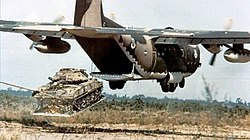Low Altitude Parachute Extraction System
The Low Altitude Parachute Extraction System (Lapės) (engl .: parachute extraction at low altitude ) is a military method of a fixed-wing aircraft settle loads when a landing is not possible and the target area is too small, precisely around the load from high altitude.
The method was developed in 1964 by the 109th Quartermaster Company of the US military . In May 1965 she was sent to Vietnam to support the troops there. Among other things, they dropped cargo from great heights during the Battle of Khe Sanh and in the LAPES procedure. The LAPES was used to transport heavy loads to Khe Sanh that otherwise could not have been brought there.
In the LAPES process, the freight is strapped onto a special pallet and fixed on it. When the transport aircraft reaches the drop zone, the machine goes into a steep descent to two meters above the ground with its landing gear extended. The cargo is pulled out of the cargo hold by means of a braking parachute and braked on the ground. After ejection, the machine goes back to climb .
The method allows the transport aircraft to keep moving and still deliver cargo to the ground. However, the procedure is associated with high risks, so that it is rarely used.
